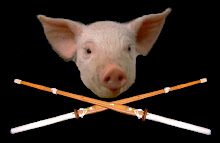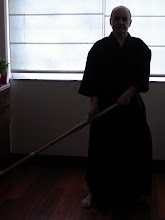GENERAL DO’S AND DON’TS:
Be committed and
come to class regularly. If not, you not
only waste your time, but you waste your instructor’s time and you may keep
class progression at a slower pace.
Be on-time if not
early to class. If late, enter quietly
without distracting others. Dress,
prepare, and warm up before joining the session. Wait until an exercise is complete, step into
the group, and bow. Similarly if you
have to be excused before the end of the practice, let sensei or a senior know.
Never sit or rest
without permission unless you feel ill during class. If ill or injured, bow out and get well. Only you know your body.
Make the most of
every practice. Come prepared mentally
and physically.
It is customary to
walk behind a kendoka wearing armor and standing or sitting in position. If it
is unavoidable, stretch your right arm in front of you, bow slightly, and
excuse yourself while passing.
While instruction
is being given by the sensei, sempai, or visiting teacher, do not interrupt, contradict,
or be uncooperative. Do not allow your attention to wander during instruction.
Do not lean
against the wall or on a shinai, using it as a cane.
Do not wear a hat,
speak loudly, or use abusive language in the dojo.
Always place your
shinai or sword out of the way, where others cannot stumble over or step on it.
Do not rest it against the wall in an upright position.
Never step on or
over a shinai, iaito, bokuto, or any representation of a sword.
Never kick, step
on, or move someone’s bogu; treat them with respect.
Always bow to your
opponent before and after a keiko. Show
respect by saying loud and clear, "onegaishimasu" while bowing before
engaging and "arigato gozaimashita" after engaging.
If your armor
becomes loose or untied, raise your right arm to signal you need to stop, step
back, correct the problem, then start again with a standing bow.
Always place
safety first.
Always take the
opportunity to practice with higher ranks, and never allow a sensei or senior
student to stand idle.
Always show your
best reigi (etiquette), shisei (attitude), and kigurai (pride) wherever you
practice. Not only do you represent
yourself, your represent your dojo, your sensei, and your sempai.

